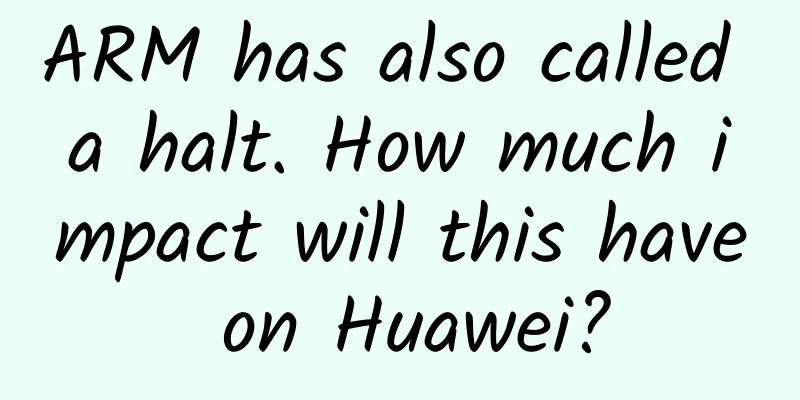ARM has also called a halt. How much impact will this have on Huawei?

|
Yesterday afternoon (May 22), ARM China's PR called Huxiu directly and said that the new product (AI-related) launch conference originally scheduled to be held in Shenzhen in early June was "cancelled" and there was no specific plan to postpone it. After hanging up the phone, I actually had the worst idea in my mind. As expected, at around 7 o'clock last night, the BBC directly obtained ARM's internal notification document: because it contains technology from the United States, ARM (UK) has asked employees to "stop all effective contracts, support and pending agreements with Huawei and its subsidiaries." After seeing this news, Huxiu also learned some of the situation from relevant people from ARM China - ARM China's new product launch conference was cancelled, also because of pressure from its British parent company, and it was obvious that they wanted to completely avoid suspicion. Huawei also issued a brief statement later:
At this point, ARM's complete suspension of cooperation with Huawei has become a foregone conclusion. But how should we view this matter? 1. What is ARM? For some people, the name ARM is not unfamiliar. After all, it is a company that has promoted the entire smartphone era with its own technology. ARM's flagship product is the "ARM processor", which features the use of RISC (Reduced Instruction Set, as opposed to the complex CISC instruction set used by PCs), which makes the entire processor more efficient by streamlining the underlying operation of the computer. This also makes it the best choice in the era of smart terminals with limited power and mobile use. Of course, there is another very important point, which is ARM’s own operating mechanism - ARM itself does not sell physical products, but only sells technology licenses. From the most basic instruction set to specific Core design, and even subsequent processor optimization and modification, there are special technology licensing projects. This model itself is a great invention, comparable to TSMC's foundry business to some extent, for two main reasons: First, it greatly lowers the entry threshold for mobile processors. Designing chips is not an easy or fun task. Not to mention how to recruit enough talents to carry out cutting-edge technology research and development, there is also the tape-out and testing that may cost tens of millions of dollars at a time, and finally the compatibility and optimization of software and hardware, etc. However, due to the existence of ARM, the burden of mobile phone processor manufacturers has been lightened, because they no longer need to carry out the highest-risk processor underlying development. Instead, they can directly purchase licenses from ARM, and then take this license to their own wafer fab or other wafer foundries, and use the chip design information provided by ARM to "quickly (compared to self-developed chips)" produce the CPU, SoC and other chips they need. Moreover, this model is actually full of pressure. ARM also needs to bear the expectations of the entire ecosystem for the progress of processor performance. If it wants to earn more revenue, it can only further expand the ARM ecosystem. This is undoubtedly a company worthy of admiration (the media that say ARM is making money without doing anything can go back to sleep). Second, ARM's authorization mechanism ensures the order of the overall ecosystem and maintains good compatibility between the software and hardware ecosystems. Unlike the X86 architecture of the PC era, ARM's RISC architecture has actually evolved greatly. In the face of huge performance requirements, ARM's instruction set has evolved more than ten times. If you want to give full play to the hardware performance of a processor, then the software system must provide good support for these instruction sets. It is also because of the existence of ARM that the evolution rhythm of the instruction set of the entire ARM processor has been well controlled. The system does not need to frequently adapt to new instruction sets, but can also optimize the instruction sets at a deeper level. As for why ARM has now turned its back on Huawei, how much American technology does the current ARM processor contain? As of press time, Huxiu has not been able to get an explanation from relevant sources. But it is believed that it is under direct pressure from the US government. To paraphrase Ren Zhengfei's answer in an interview the day before yesterday: "The United States is a country ruled by law. American companies cannot fail to abide by the law, and the real economy must abide by the law. The media should stop criticizing American companies. Everyone should speak up for American companies. If you want to criticize, criticize American politicians." 2. What is the situation of ARM China? Just last May, Huxiu made a special report on the establishment of ARM's joint venture in China ("China's First Breakthrough in Chip Manufacturing"). Previously leaked ARM China fundraising PPT The biggest highlight of this joint venture is that Chinese investors hold a 51% stake, ARM holds a 49% stake, and directly takes over all of ARM's business in China. Previously leaked ARM China fundraising PPT Unfortunately, management dominance does not mean the transfer of overall technology. In a leaked ARM China fundraising PPT at the time, the licensing relationship between ARM China, ARM UK parent company and Chinese customers was clearly shown: ARM UK parent company first authorized ARM China, and then ARM China could authorize Chinese customers, and this order could not be disrupted. Considering that ARM's UK parent company has already issued a notice to suspend cooperation, ARM's Chinese subsidiary has no way to authorize Huawei to obtain corresponding technology authorization without the permission of its UK parent company. It is interesting to note that the establishment of ARM China is closely related to the rise of HiSilicon. Firstly, Huawei's smartphones continue to grow rapidly. Secondly, Huawei itself is a leader in the entire communications field. Now it has developed ARM server CPUs such as Kunpeng 920. Establishing a Chinese subsidiary will undoubtedly make cooperation between the two parties more convenient. 3. How big an impact will Huawei suffer? Objectively speaking, it should be bigger than most people think. According to ARM's own financial report, sales in China accounted for about 20% of ARM's global sales in fiscal 2018, and most of this figure was contributed by Huawei HiSilicon. As we mentioned above, ARM's processor licenses are diverse, but from the lowest-level infrastructure to the final processor, they can be mainly divided into the following categories:
According to the existing information, Huawei has probably obtained a permanent license for the ARMv8 instruction set. In other words, Huawei can at least develop ARM processors on its own and continue to enjoy the compatibility of the entire ecosystem with this instruction set. But the bad thing is that the ARM Core license, which is still being iterated and updated, as well as processor improvement and optimization, in-depth collaboration, etc., will definitely be affected by the suspension of cooperation. From the actual product level, if the relevant ban of the United States continues, and if Huawei still wants to maintain sufficient competitiveness in its own products, then Huawei will actually have to complete the original workload of "ARM + competitors" . You know, the former is a veteran semiconductor company that has been deeply involved in the RISC processor field for nearly 30 years and has more than 6,000 employees. It is highly likely that Huawei HiSilicon will find it difficult to withstand such a huge challenge all at once. However, the Kirin 985 processor, which was exposed a few months ago and is rumored to be released next month, is unlikely to be affected too much . After all, according to the usual research and development time in the semiconductor industry, the Kirin 985 should have entered the stage of large-scale tape-out. As for the Kirin 990, which comes after the 985, there is not enough information to judge the extent of the impact. But what is certain is that all projects after Kirin 990 will encounter considerable troubles, not to mention new areas that Huawei's own chips are involved in, such as server processors and base station chips. 4. Personal views and conclusions To some extent, I personally think that ARM's suspension of cooperation is not the most serious. Take mobile phone SoC chips for example, Huawei's Kirin 980 has actually reached the world's leading level (performance, communication capabilities, energy consumption), and we are now in a period of gap between the continued popularization of 4G networks and the ongoing promotion of 5G. The performance of smartphones themselves has also entered a relatively slow development period, so if you really want to use Kirin 980 for a year or two, it is not impossible. In comparison, chip production is much more difficult. The excellence of Kirin 980 is also due to TSMC's 7nm process technology to a certain extent. At present, the stable mass production level of domestic wafer fabs is still around 14nm. To make a simple algorithm, if the process is 2 times different, the area will be 4 times larger (the process is the side length, and the area needs to be squared), and the power consumption and heat generation will also increase simultaneously. After becoming "fat", Kirin 980 will definitely not fit into your current mobile phone. There is no doubt that today China will certainly set off a wave of calls for "independent innovation" because of ARM's suspension of cooperation. But it is also at this time that we need to go back and read the two sentences that Ren Zhengfei said in an interview the day before yesterday:
Because semiconductors really are an industry that has to be "globalized." Image from: Moore Elite In 2017 alone, the total output value of the entire semiconductor industry reached 430 billion US dollars, and the resulting electronics industry reached 1.5 trillion US dollars. This does not include the high material costs and R&D investment in the semiconductor industry. In such a fast-paced and highly competitive cutting-edge technology industry, blindly pursuing independent innovation may be the worst outcome. |
<<: Huawei's self-developed operating system Project Z, which replaces Android, is exposed
Recommend
2021 Douyin short video with no source of goods [updating]
The latest Douyin short video with no source of g...
How about Baidu bidding hosting agency?
"The world is complicated, and Baidu underst...
WeChat "Group Administrator" function is launched. What new community gameplay are there?
WeChat has been online for seven years, but WeCha...
iOS A Song of Ice and Fire – Using XPC to pass the sandbox
0x00 Sequence Ice refers to user state, and fire ...
These mobile phone functions and skills can solve holiday battery anxiety
Although there has not been a revolutionary impro...
2020 Tour Guide Certificate Examination Time Confirmed Tour Guide Qualification Certificate Registration Time Entry Query
The General Office of the Ministry of Culture and...
User experience report: It’s not easy to say I love you, Apple Pay binding failed
I was surprised to hear that ApplePay has officia...
As Tik Tok becomes Vlog, what opportunities are there for brand marketing?
This year, especially since the second half of th...
How does Watsons conduct user operations?
The Internet has been developing for more than 10...
The battle for product placement in the chicken-eating game has begun. Which brand is the hidden chicken-eating king?
I believe everyone must have seen JD.com’s Double...
Ximalaya FM Product Experience Analysis Report (Part 1)
As the largest audio platform in China, Himalaya ...
An inventory and analysis of mainstream promotion channels, teaching you how to spend 10 million promotion fees
People often ask, which promotion channel is more...
What are the functions of WeChat mini program of Guangzhou milk tea shop? How to set up WeChat mini program of Guangzhou milk tea shop?
After the Qingming Festival, the temperature bega...
Five Thanksgiving marketing tactics
The annual Thanksgiving is coming again! Is the p...
Shengunju Practical Home Feng Shui Course 24 full video + notes Baidu cloud download
Baidu network disk location: n-30-Shen Gun Bureau...









